Tips for Better Process Pump Lubrication
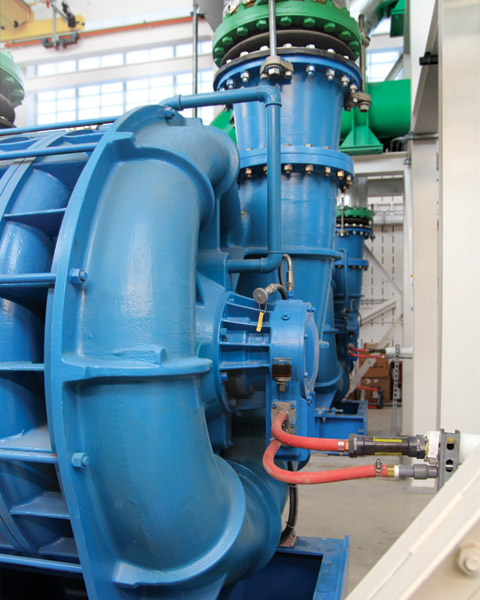 The overwhelming majority of process pumps in industry comply with the standards of the American National Standards Institute (ANSI) or the American Petroleum Industry (API). However, neither of these two standard categories mandates any one particular type of lubrication. Grease lubrication, as well as lubrication by liquid oil or atomized oil (oil mist), or even pressurized pure oil are used in various process pumps. Generally, grease is chosen for ease of lube containment, but it is limited to relatively small ANSI pumps. The larger pumps and virtually all API-style pumps are oil-lubricated, but lube type selection and the designs that apply lube to bearings can vary.
The overwhelming majority of process pumps in industry comply with the standards of the American National Standards Institute (ANSI) or the American Petroleum Industry (API). However, neither of these two standard categories mandates any one particular type of lubrication. Grease lubrication, as well as lubrication by liquid oil or atomized oil (oil mist), or even pressurized pure oil are used in various process pumps. Generally, grease is chosen for ease of lube containment, but it is limited to relatively small ANSI pumps. The larger pumps and virtually all API-style pumps are oil-lubricated, but lube type selection and the designs that apply lube to bearings can vary.
Lubricant types are categorized as either mineral oils or synthetic oils, and they certainly differ in cost. Also, lubricants need to remain relatively clean in service, and lube change intervals must be optimized. In short, important choices and decisions will need to be made. Therefore, guidance from reliability improvement and cost points of view will be necessary.
Oil Rings Interact with Lubricant Viscosities
Viscosity is by far the most important property of lubricants applied to process pump bearings. In general, thicker viscosity oil films will protect rolling-element bearings better than oils with thinner viscosity. For process pumps with rolling-element bearings, ISO Grade 68 (VG 68) lube oils will allow higher operating loads than VG 32. The problem is that oil rings or slinger rings that are optimally designed to apply VG 32 will not work equally well with the more viscous VG 68.
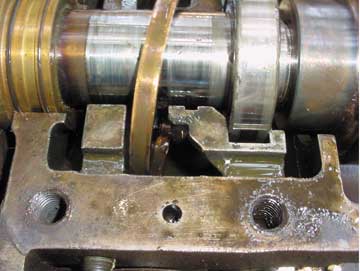 Oil rings typically operate best in an as-designed speed range with closely maintained depth of immersion, ring concentricity, shaft system horizontality and surface roughness of contacting parts. For long life and low frictional losses, different bearings are sometimes best lubricated with different viscosity lubricants. But what if these bearings share the same bearing housing? Reliability-focused pump users will need an optimization strategy, and lube-related knowledge will help.
Oil rings typically operate best in an as-designed speed range with closely maintained depth of immersion, ring concentricity, shaft system horizontality and surface roughness of contacting parts. For long life and low frictional losses, different bearings are sometimes best lubricated with different viscosity lubricants. But what if these bearings share the same bearing housing? Reliability-focused pump users will need an optimization strategy, and lube-related knowledge will help.
Fortunately, ISO Grade 32 synthetic lubricants exhibit oil film thickness and strength properties close to those of VG 68 mineral oils. Therefore, suitably formulated VG 32 synthetic oils are preferred by reliability professionals for many process pump services.
An excellent point in favor of synthetic VG 32 can also be made for many pump drivers, such as the steam turbine bearing housings shown in Figure 2. The sleeve bearing at the drive end of this small turbine was optimally lubricated with a VG 32 lubricant, whereas the rolling-element bearing at the governor end (the thrust-loaded bearing) would survive longer if VG 68 oil could be applied. Because of their superior properties, VG 32 synthetic lubricants incorporate the viscosity needed for reasonable oil ring performance as well as oil film thickness and tenacity characteristics desired for bearing life extension.
Here are a few general guidelines worth considering:
-
Using a mineral oil would generally require oil to be changed every six to 12 months. With a clean, premium-grade synthetic lubricant, you would typically extend oil change intervals to at least 24 months. Incorporating the advanced bearing housing protector seals shown in Figures 3 and 4 and guarding against contaminant entry at breather vents could make 36-month change intervals possible.
-
ISO Grade 32 mineral oils are often considered too "thin" for pump bearings. They rarely qualify for long-term, risk-free use in pumps equipped with rolling-element bearings in typical ambient conditions. But simply switching to ISO Grade 68 mineral oils will be risky for bearings that depend on oil rings for lube application.
-
Appropriately formulated with the right base stock and with proprietary additives, ISO VG 32 synthetics are quite acceptable from film strength and film thickness points of view. In fact, the performance of some ISO VG 32 synthetics duplicates that of ISO VG 68 mineral oils. These superior ISO VG 32 synthetics excel by simultaneously satisfying the requirements of sleeve and rolling-element bearings.
-
Superior synthetics achieve high film strength through proprietary additives, so there can be significant differences in the performance of two lubricants of the same viscosity and base stocks. Only one might be suitable for the highest reliability services.
-
The notion that one oil type or viscosity suits all applications is rarely correct. Similarly, no fixed or particular oil ring geometry is ideally suited for all oil types and viscosities. Custom-designed oil rings may be required to work with the thicker oils at certain high shaft peripheral velocities.
Although synthetic lubricants cost more than mineral oils at the point of initial purchase, rigorous and all-encompassing cost justifications will often show relatively short payback periods. Combining extended bearing life and extended drain intervals results in better payback. This is made possible by keeping contaminants away from the lubricant. Therefore, upgrading to the best-available bearing protector seals and implementing plant-wide oil-mist lubrication are two principal strategies adopted by world-class plants.
Protect the Lubricant for Longer Bearing Life
Air and the lubricant take up whatever housing space is not actually used by the bearings. For bearings to survive, solid particles and water intrusion must be avoided. For this reason, proper bearing housing protection seals are essential for keeping the oil clean. Reliability-focused users are mindful of the fact that non-optimized bearing housing protector designs can hurt oil cleanliness by shedding slivers of sealing components.
Keeping the oil clean is the first order of business if extended oil replacement intervals are the goal. In turn, achieving extended oil replacement intervals often makes it economical to use superior-quality synthetic lubricants. In combination, advanced bearing protector seals and synthetic lubricants create an environment conducive to long bearing life. Common sense and statistical evidence point to greatly reduced downtime risk and demonstrable maintenance cost avoidance credits.
Because synthetic lubricants are more expensive than mineral oils, some users cling to mineral oils for their process pumps. They also may employ inadequate bearing housing seals because their only concern is the initial purchase price. Wear-prone seals include lip seals and also certain rotating labyrinth seals. Seals to avoid are those that allow a rotating O-ring to contact the sharp edges of an O-ring groove, or O-ring grooves that are wide enough to prevent such contact but that enable copious amounts of contaminants to enter the bearing housing.
While even small machine manufacturers recognize the need to limit both contaminant ingress and oil leakage, inexpensive lip seals are found in some pumps and drivers to keep initial cost low. Yet lip seals typically last only about 2,000 operating hours (three months). When lip seals are too tight, they cause shaft wear and in some cases lubricant discoloration known as "black oil." Once lip seals have worn and no longer seal tightly, oil is lost through leakage, or contaminants find their way into bearing housings. This fact is recognized by the API-610 standard for process pumps, which disallows lip seals and calls for either rotating labyrinth-style or contacting face bearing housing protector seals.
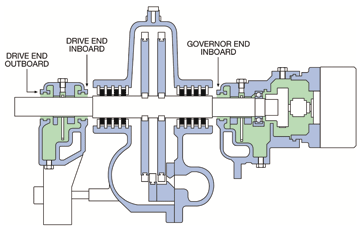 Small steam turbines often suffer from steam leakage at both drive and governor-end sealing glands. Each bearing housing is located adjacent to one of these two glands, which contain carbon rings. As soon as the internally split carbon rings start to wear, high-pressure and high-velocity leakage steam finds its way into the bearing housings. Traditional labyrinth seals have proven ineffective in many such cases, and only solidly engineered bearing protector seals are effective in blocking leakage steam intrusion.
Small steam turbines often suffer from steam leakage at both drive and governor-end sealing glands. Each bearing housing is located adjacent to one of these two glands, which contain carbon rings. As soon as the internally split carbon rings start to wear, high-pressure and high-velocity leakage steam finds its way into the bearing housings. Traditional labyrinth seals have proven ineffective in many such cases, and only solidly engineered bearing protector seals are effective in blocking leakage steam intrusion.
The bearing housing protector seal in Figure 3 was designed for steam turbines. It incorporates a small- and large-diameter dynamic O-ring. This bearing protector seal is highly stable and not likely to wobble on the shaft; it is also field-repairable. With sufficient shaft rotational speed, one of the rotating ("dynamic") O-rings is flung outward and away from the larger O-ring. The larger cross-section O-ring is then free to move axially, and a micro-gap opens up.
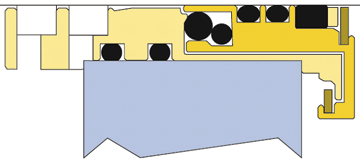 When the turbine is stopped, the outer of the two dynamic O-rings will move back to its standstill position. At standstill, the outer O-ring contracts and touches the larger cross-section O-ring. In this design, the larger cross-section O-ring touches a relatively large contoured area. Because contact pressure equals force divided by area, a good design aims for low pressure. In outdated configurations, contact with the sharp edges of an O-ring groove risks O-ring damage, and slivers of O-ring material can end up contaminating the lube oil.
When the turbine is stopped, the outer of the two dynamic O-rings will move back to its standstill position. At standstill, the outer O-ring contracts and touches the larger cross-section O-ring. In this design, the larger cross-section O-ring touches a relatively large contoured area. Because contact pressure equals force divided by area, a good design aims for low pressure. In outdated configurations, contact with the sharp edges of an O-ring groove risks O-ring damage, and slivers of O-ring material can end up contaminating the lube oil.
Upgrade to a Better Bearing Environment
Fortunately, concerns as to the time it might take to upgrade to advanced bearing protector seals have been alleviated. Modern products fit in the space previously taken up by lip seals.
In 2009, when a Dutch refinery asked for the installation of the bearing protector seal shown in Figure 3 for one of its steam turbines, no modifications were allowed on the existing equipment. Installation of three bearing protector seals on the first machine had to take place during a scheduled plant shutdown.
 With no detailed drawings of the bearing housings available, the exact installation geometry could only be finalized after dismantling the small turbine seen in Figure 2. One of the main problems was the short outboard length - less than 0.25 inch was available due to the presence of steam deflectors and oil flingers. But the manufacturer's engineers were able to modify the advanced design to fit into the existing groove of the original equipment manufacturer's labyrinth seals. Delivery was made within one week of taking measurements of the steam turbine and bearing housings, and the turbine has been running flawlessly for years.
With no detailed drawings of the bearing housings available, the exact installation geometry could only be finalized after dismantling the small turbine seen in Figure 2. One of the main problems was the short outboard length - less than 0.25 inch was available due to the presence of steam deflectors and oil flingers. But the manufacturer's engineers were able to modify the advanced design to fit into the existing groove of the original equipment manufacturer's labyrinth seals. Delivery was made within one week of taking measurements of the steam turbine and bearing housings, and the turbine has been running flawlessly for years.
The point is that highly cost-effective equipment upgrades are possible at hundreds of refineries. However, superior bearing protector products for use in steam turbines must be purposefully developed. Compared with standard products typically used in pumps, the type described here offers important advantages, such as being suitable for high temperatures, incorporating Aflas O-rings as the standard elastomer, providing extra axial clearance to accommodate thermal expansion and utilizing high-temperature graphite gaskets. With these advantages in mind, there should no longer be any reason for water intrusion into the bearing housings of process pumps and small steam turbine drivers at reliability-focused facilities.
When running a pump, you might ultimately achieve an operating temperature that allows a certain thick oil to flow nicely, but what if the initial operating temperature at startup is quite low and the oil will not flow freely? That's what often happens when someone buys a standard "multi-purpose oil" where a superior synthetic would be a far better choice.
Of course, these and similar issues are avoided with pure oil-mist systems. These systems eliminate much of the human element and are less maintenance-intensive than traditional pumps and drivers lubricated with vulnerable oil rings and constant-level lubricators.
Oil Mist Represents Best Available Technology
As stated previously, thick oils can be quite difficult to apply with the oil rings that are typically supplied with API process pumps. These oils are more easily and reliably applied as an oil mist. Neither oil rings nor constant-level lubricators are used in pumps and drivers connected to plant-wide oil-mist systems.
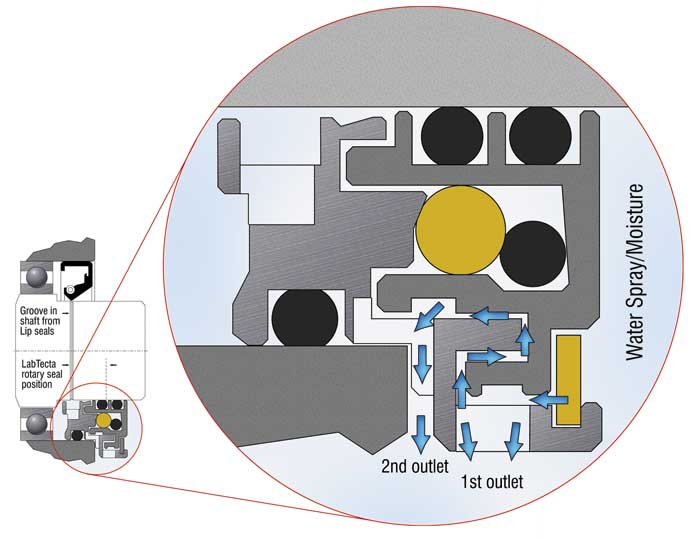
Oil mist is an atomized amount of oil carried or suspended in a volume of pressurized dry air. The oil mist - actually a ratio of one volume of oil suspended or carried in 200,000 volumes of clean, dry air - moves in a piping system. The point of origin is usually a simple mixing valve (the oil-mist generator) connected to a header pipe. Branch lines often feed hundreds of rolling elements in pumps and drivers connected to the header.
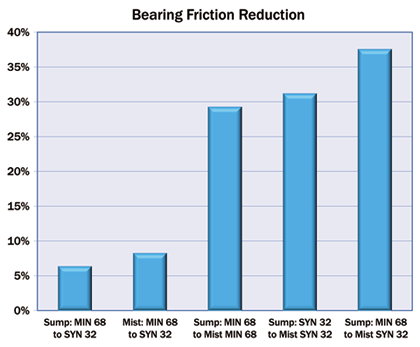 At standstill, or while on standby, pump and driver bearings are preserved by the surrounding oil mist, which exists in the bearing housing space at a pressure just barely higher than ambient. These pump and driver bearings are lubricated from the time when atomized oil globules join to become larger oil droplets. This combining begins whenever the equipment shafts rotate, which is when small globules get to contact each other and start coating the bearing elements.
At standstill, or while on standby, pump and driver bearings are preserved by the surrounding oil mist, which exists in the bearing housing space at a pressure just barely higher than ambient. These pump and driver bearings are lubricated from the time when atomized oil globules join to become larger oil droplets. This combining begins whenever the equipment shafts rotate, which is when small globules get to contact each other and start coating the bearing elements.
There are also plant-wide oil-distribution systems whereby liquid oil (not an oil/air mixture) is pressurized and injected through spray nozzles into the pump bearings. These oil-spray systems are not to be confused with the more economical oil-mist systems. However, both oil-mist and oil-spray applications can take credit for lower frictional losses (see Figures 5 and 6) and should be taken into account when doing cost-justification analyses.
Using High-Film-Strength Synthetic Lubricants
Good lubrication practices include choosing the right oil, taking proper care of it and changing it before bearings are harmed. Improvements in lubricant quality can only be achieved by utilizing oils with superior lubricating properties. These would be premium synthetics.
Yet even among prominent synthetic lubricants, oil performance can vary greatly based on the amount and composition of additives in the oil. For process pump bearing lubrication, at least one company combines synthetic base oils including polyalphaolefin (PAO) and dibasic ester base stocks with advanced additive chemistry to realize greater film strength.
Numerous incidents have been documented where advanced lubrication technology has significantly improved pump reliability. In the majority of cases, advanced lube technology with its often more favorable (lower) coefficient of friction results in reduced bearing operating temperatures.
Micro-cracks in bearing surfaces can cause increased noise and vibration. Suitable high-film-strength oils will fill these micro-cracks. This then lowers noise intensity and reduces vibration severity.
High-film-strength lubricants also lessen the probability of lube oil darkening during the running-in period of bearings with brass or bronze cages. There have been reported instances of high frictional contact during the initial run-in period of the copper-containing material recommended by API-610. If the net axial thrust action on one of the two back-to-back oriented bearings causes it to become unloaded, it may skid.
The risk of lube oils darkening during the run-in period of such pumps is reduced through the use of high-film-strength synthetic lubes. To be fair, this risk could also be reduced by insisting on impeccable installation techniques and the selection of bearings with cages made of advanced high-performance polymers. The API-610 stipulation of using thrust bearings with particular load angles and brass cages represents a compromise, which is especially attractive for plants that place the desire to standardize ahead of failure-avoidance concerns.
Whatever the differential cost of a quart of high-film-strength synthetic, it is insignificant compared to the value of an avoided failure incident on critical, non-spared refinery pumps. Therefore, critically important pumps, pumps in high-temperature service and pumps that have failed more often than others in the plant's pump population should be lubricated with high-film-strength synthetic oils. Their higher cost is easily justified by four to six times conventional oil replacement (draining) intervals and by keeping the oil free from contamination. Oil contamination is effectively avoided by installing advanced bearing protector seals.
On pumps where a problem is in progress, changing to a superior synthetic is highly recommended. If access to the sump drain is safe when the pump is in service, the present oil can be drained while such pumps are on-line and running. Many superior synthetics are compatible with the oil presently used in a particular pump. Still, compatibility must be verified.
Of course, there are certain pump bearing or lube degradation problems that have nothing to do with the lubricant type. In those instances, nothing will be gained by changing over to better oils.
Lubricants for Oil-Mist Systems
Pure oil-mist lubrication eliminates the need for oil rings or flinger discs. No liquid oil sumps are maintained in the bearing housings, hence the term "dry sump" is often used to describe modern oil-mist lubrication. ISO VG 68 and VG 100 mineral or synthetic oils are used, although properly formulated ISO VG 32 synthetics (but not mineral oils) will serve the majority of pump bearings and also virtually all types of rolling-element bearings in electric motors.
Decades of experience on thousands of pumps and electric motors attest to the viability and cost effectiveness of modern plant-wide oil-mist systems. Typical payback periods when using oil mist on problem pumps have generally been less than one year.
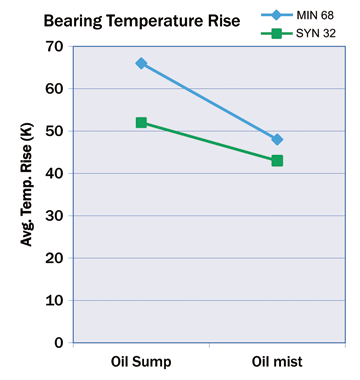 Bearing friction can be reduced by switching to different oils, going with a different lube application method or switching both lube application method and oil type. Five different modifications were closely examined in a cooperative effort involving a multi-national lube oil producer and a prominent bearing manufacturer. The results were plotted, and percentage reductions in bearing friction displayed on the vertical scale in Figure 5. There are also temperature advantages associated with different oils and different lube application methods (see Figure 6).
Bearing friction can be reduced by switching to different oils, going with a different lube application method or switching both lube application method and oil type. Five different modifications were closely examined in a cooperative effort involving a multi-national lube oil producer and a prominent bearing manufacturer. The results were plotted, and percentage reductions in bearing friction displayed on the vertical scale in Figure 5. There are also temperature advantages associated with different oils and different lube application methods (see Figure 6).
Remember, by consistently staying within acceptable ranges of dimensional, material composition, fabrication-specific and application-related parameters, you can avoid process pump failures. Of course, operations, maintenance and project engineering must cooperate. Still, adherence to sound specifications is not difficult once a proper mindset is cultivated. The difficulty is in cultivating the mindset.
